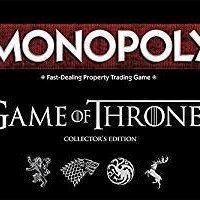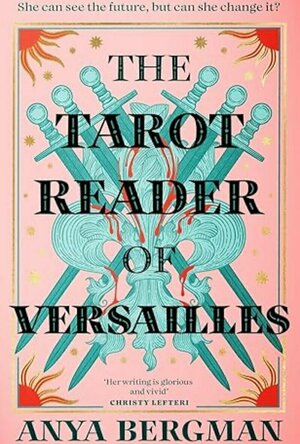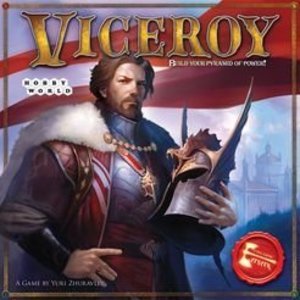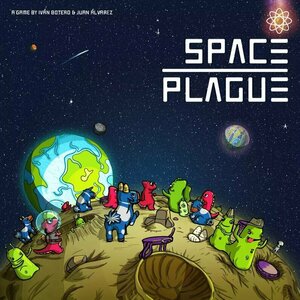
Super Scores - Soccer Live Scores
Sports and News
App
Super Scores is the FREE best live football scores (live soccer scores) report application with the...

Richman 4 fun
Games
App
Enjoy classic monopoly game play in Richman 4 fun's world where you can use your business strategies...

Goblin Teeth
Tabletop Game
In deep dark we live. It cold, it damp, but home to fancy emerald, yummy worms, and other lovely...

Monopoly: Game of Thrones
Tabletop Game
The race for control of Westeros is on with this brand new special Monopoly game. With artwork from...

The Grizzled
Tabletop Game
he Grizzled is a cooperative game about survival in the trenches during the first World War where...

Raptor
Tabletop Game
Mamma Raptor has escaped from her run and laid her eggs in the park. A team of scientists must...
Boardgames 2BrunosGames DinoGames 2015Games 2playergames

Joking Hazard
Tabletop Game
From the creators of Cyanide & Happiness comes a card game where players compete to finish an awful...

The Tarot Reader of Versailles
Book
Two women. An extraordinary power. In a time of revolution, betrayal could lie in the turn of a card...
Historical Fiction French Revolution Irish Rebellion
Purple Phoenix Games (2266 KP) rated Viceroy in Tabletop Games
Jun 12, 2019
Power. That’s what everyone wants, isn’t it? Well, at least it is in Viceroy! As an inhabitant of the world of Laar, you are fighting to become the ultimate ruler. Recruit allies who provide strategic advantages and enact laws that solidify your claim for power. Do you have what it takes to build and maintain a powerful kingdom, or will your attempts fall short?
DISCLAIMER: There is an expansion to this game, but we are not reviewing it at this time. Should we review it in the future we will either update this review or post a link to the new material here. -T
Viceroy, a game of card drafting and tile placement, is played over 12 turns in which players build a pyramid with their cards – paying to place each card and collecting rewards based upon which level of the pyramid a card is placed. Each turn is divided into two phases: Auction and Development. During the Auction Phase, players bid gemstones to buy a card from the auction line. Once every player has either collected 1 card from auction or passed, play moves to the Development Phase. During the Development Phase, players can either play a card into their pyramid, pass, or discard a card and take 2 gemstones from the reserve. To play a Law card into your pyramid, you place it for free. To play a Character card into your pyramid, you have to pay for it with gems. The cost is dependent upon which level of the pyramid the card is to be placed. You must pay for the level the card will sit on, as well as pay the cost for every level beneath it. For example, to add a card to the third level of the pyramid, you must pay the cost for the 3rd level, AND 2nd level, AND 1st level. The rewards gained from adding a card to the pyramid, however, are taken only for the level on which the card sits. In the earlier example, you would only get the reward for the third level alone, since that is the level on which the card sits. The Development Phase is played over 3 rounds, so a player could play up to 3 cards into their pyramid during 1 Development Phase. After the 3 rounds are up, the next turn begins again in the Auction Phase. When all cards are gone from the Auction Deck, the game ends. Players count up all of their Power Points, and the player with the highest Power value wins!
The only change in Viceroy between a group and solo game is during the Auction Phase. Obviously, if you are playing solo, there is nobody to bid against for cards. How that is alleviated is that you still bid your gemstone as normal, and you randomly draw an unused gemstone from the box as an AI bid. If the colors match, you lose your gem and go on to the next auction. If the colors do not match, you collect your choice card, and the card the AI would have collected gets discarded. If the AI color does not match an available card, you just discard one of the remaining cards. This mimics group play in the sense that you might not always get the card you want from auction! The Development Phase is played as normal. At the end of the game, count points as normal and try to beat your own high score.
Viceroy is a neat game. Every card has so many options that there is no one single strategy that is a sure-win every time. Maybe one game I’ll go for Magic tokens. And maybe the next I’ll try to go for raw Power Point tokens. The possibilities really are endless, and that keeps this game fresh for me. I don’t feel like I’m just going through the motions because every card will act differently depending on where it is played. Strategy really is everything here. On the flip-side of that, however, is that sometimes the options can be a little overwhelming. With so many possibilities for each card, it can get hard for me to decide on what strategy I really want to use. It should also be noted that a card can only be played onto a level if it can sit on exactly 2 cards on the level beneath it. So sometimes I buy a card to play on a certain level only to get to the Development Phase and realize I don’t have a legal place to which I can play it. So do I sacrifice other cards/gemstones to build a slot for this one card, or do I play it to a different level and change my strategy a bit? There’s a little bit of a learning curve, but the more I play, the better I get (or at least, the better I think I get).
Another grievance with Viceroy is that I find myself running out of cards in my hand a lot. The only opportunity to draw cards is if you play a card into your pyramid that allows you to do so. And since I’m usually focused on other strategic routes, I don’t use those cards for those purposes. So then I play all of the cards in my hand (leaving me empty-handed), get 1 card at the next auction, play it, and am again left with no cards in my hand. To fix this issue, I wish one of the actions you could take during the Development Phase was to draw 1 card. I’m not sure if other people have this issue, or if it’s just me, but it’s a problem I run into almost every game.
Overall, I think Viceroy is a good game. It’s unique in the sense that there are so many possibilities that you’ll probably never play the same game twice, even if you decide to play by the same strategy. The mechanics and gameplay are cool too – it’s fun to watch your pyramid literally grow in front of you as the game progresses. This game takes a little more focus and thought than you might think, so it’s not one I’d necessarily just pull out for some light fun. I think Viceroy is as exciting as a solo game as it is as a group game since there really aren’t any differences between the two settings. If you like Viceroy, give it a try solo! If you’ve never played Viceroy, try it either solo or in a group – it’s the same game after all!
https://purplephoenixgames.wordpress.com/2019/04/18/solo-chronicles-viceroy/
Purple Phoenix Games (2266 KP) rated Space Plague in Tabletop Games
Mar 9, 2021
Space Plague is a new game from first time designers who hail from the country of Colombia. In it players assume the command of a race of aliens attempting to colonize a newfound planet before the other races assume majority. Each race is essentially the same, and have similar tactics, but may use these tactics differently from other races. The player who amasses the most plagues from their race by the time the game ends will be crowned champion, and settler of the new world.
DISCLAIMER: We were provided a prototype copy of this game for the purposes of this review. These are preview copy components, and I do not know for sure if the final components will be any different from these shown. Also, it is not my intention to detail every rule in the game, as there are just too many. You are invited to download the rulebook, back the game through the Kickstarter campaign, or through any retailers stocking it after fulfillment. -T
To setup, follow the instructions, as there are many steps for setup. Once complete, the game should look similar to the photo below. You will see in this photo the main board at the top, the circular world core board (in black and red), and individual board setups for three players. Of course, for this review I will be playing the purple faction: The Flat-Earthers (not that I agree with the actual group of Flat-Earthers). Each player receives the same components, just in their player color. This includes six action cards to serve as the opening hand.
Each round follows four phases: Planetary Deck, Play Action Cards, Planetary Event, and March. On the main board a Planetary Event Card is flipped at the start of each round. This will inform the players which terrain type will generate energy this turn, as well as give a glimpse into the future event that will occur once the card travels to the activation zone on the board. Once players have placed energy shards onto the requisite terrain tiles they must each choose one card to be played this turn from their hand. As each player has the same six beginning Action Cards turns may seem similar. These action cards include Producing Plague (placing a plague disc on the space furthest from the end of the terrain tile line, on top of the picture of the player’s spaceship), Producing a Captain (a stronger version of the normal plague disc), Fast Movement (allows plague discs to move twice toward the core or two discs to move one space each), Slow But Steady (allows one plague disc to move forward one space OR allows the player to place a shield disc on top of a plague to protect it from harm), and Evolving OR Getting Lucky (which allows the player to purchase an Evolution Card from the Market or to roll the energy die and place energy shards on the resulting terrain type). More action cards can be purchased at the Market and used on future turns in order to buff certain actions, abduct opponent plagues, or even create new types of plagues with special abilities.
Once all players have played and resolved their action card for the round the Planetary Event phase begins. If an event card has moved its way to the activation zone of the main board its event text is resolved now. These events signify death of plague discs if they reside on specific terrain types, allow for purchasing cards at the Market or else destroying the plague furthest toward the core, or other various and nefarious events.
When the event has been resolved the active player token is passed to the next player and the March phase ensues. Players will move each of their plague discs one space toward the core to make room for more incoming plagues and captains.
Once the final event card has made its way through each of the main board slots and past the activation zone the game will end. Players will count their plague discs that made it onto the core of the planet and the player with the most discs will win! The rules also include several tie-breakers, ending with a shared victory and a snarky, “tough toothpaste,” style of comment.
Components. Again, this is a prototype copy of the game, and components are not at all final. However, component quality aside, this game looks amazing on the table and hints at some really excellent plans for the final aesthetic. The character art and art on the cards is cartoony, but not in a bad way, and the other art in the graphic design is just stellar (checks around the room for the hook). The game feels “spacey” and “alieny” but also hip and lighthearted. I like it. I like it a lot. My hope for the final product is that the rulebook gets much more detailed, as I had to ask several questions to the designer that just were not clear or present in the rules. I am also hoping that the cards themselves will see quite a bit of beefiness added to them, as this prototype copy shipped with mega-thin cards that are delicate to handle. For a prototype, the components are good and show me what could be upon a successful Kickstarter campaign.
The gameplay is definitely something I want to discuss. I was blown away by how much fun I had playing this game! I cannot count how many times I vocalized how impressed I was with the design and how much fun I was having. I love the mechanic of giving all players the same components but allowing them to choose how to use them best for their strategies. Sometimes I felt that I need to flood my track with plagues and get them moving, while other times I wanted to just upgrade my race by using the evolution cards from the market. Those evolution cards are so interesting to use because they can change the course of the game, especially if specific cards come out near the beginning of the game.
Players can choose which world they wish to conquer at the start of each game (five were included with this copy), and each world possesses different strategies of play. That said, Space Plague definitely scores points for replayability from us.
While it was difficult to get into at first (remember all the rules questions I had), once I was able to truly learn the game it became so enjoyable, and everyone I have played with has thoroughly enjoyed it. If this is the style of game we can expect to come out of Colombia and Bamboo Studios in particular, I am very excited for the future and for the board game community as a whole. This one is a gem and I cannot recommend it highly enough. If you are looking for something a little kooky but with great art and super fun play, then it’s a no-brainer. Space Plague is a must-play at the very least.

